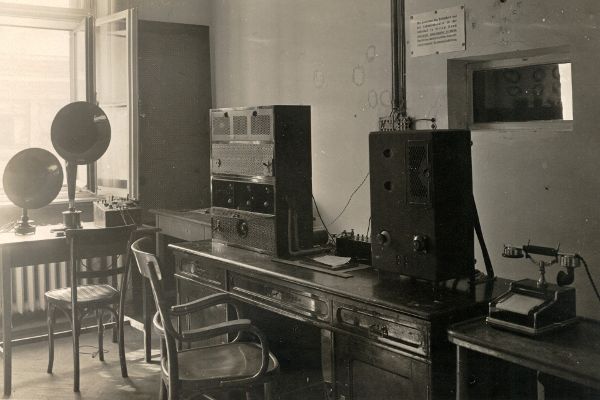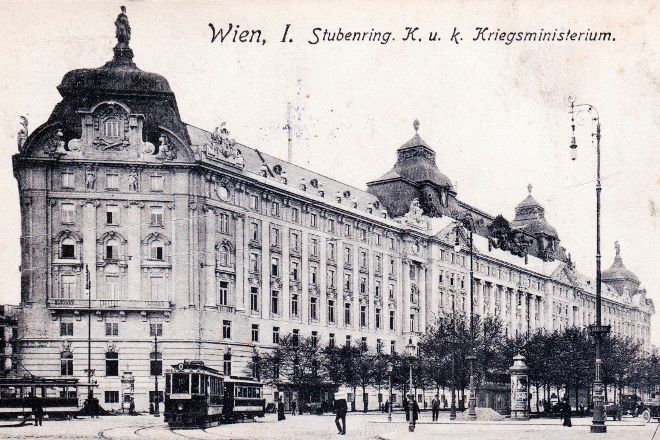The government building - a piece of radio history

In the government building on Stubenring radio history was made: The building was home to the country's very first radio studio and housed the "Stubenring Transmitter".
It was military requirements that led Austria-Hungary to modernise its communication structures in the late 19th and early 20th century. In the course of completing the new War Ministry on Stubenring, a large radio telegraph system with two 31-metre high lattice towers attached to the roof structure was erected. The accompanying equipment was kept in the machine rooms in the attic, which is now the fifth floor.
By relying on the new "wireless telegraphy" technology, the Danube Monarchy drew level with other European powers and secured radio communication with its navy warships without any difficulty. This form of communication, originally used for military purposes only, was continuously developed further and ultimately paved the way for wireless sound broadcasting services.
After World War I radio pioneer Franz Anderle inspected the equipment installed on Stubenring in view of its suitability for further use. From that point on, the system was to serve civil purposes, and the telegraph was converted into a sound broadcasting system. Trial transmissions were broadcast, technical improvements made and first plans for an Austrian radio communication concession were drawn up. In 1921 Oskar Czeija applied for a radio license. People were sceptical towards him and there were many competitors, so it took another three years before the Radio-Verkehrs-AG (RAVAG) was established on 30 September 1924, and Czeija was finally appointed its director-general.
Radio for two schillings a month
RAVAG began broadcasting daily programmes with music and informational lectures in September 1924. Regular radio transmissions started on 1 October using a makeshift studio on Stubenring. Straight after that, the "Neue Freie Presse" newspaper reported that 15,000 people had subscribed to the broadcasts, which was a remarkable number for those days. Only one year later, there were as many as 100,000 radio subscribers who listened to the programmes for a monthly fee of two schillings. Listening to the radio rapidly evolved into a mass phenomenon and the people loved it: While the cinema showed silent pictures, radio was – beside the gramophone record – the only sound medium of its time and, on top of that, the reporting was in real time.
The official name the transmissions came to be known by was "Radio Wien" and its early broadcasts were mainly classical music. In 1925 live radio broadcasts started. Wolfgang Amadeus Mozart's "The Magic Flute", for example, was transmitted live from the State Opera while other productions were broadcast live from the Salzburg Festival. Later on, RAVAG added plays, scientific lectures and a children's hour to the regular programmes. As early as in 1924 there was already a special educational programme ("Radio-Volkshochschule"), an institution that has lasted to this day in the form of the "Radiokolleg" programme still broadcast on Austrian Ö1.
However, news reports about current political events and affairs were forbidden, as consideration had to be given to the business interests of newspaper publishers. Apart from that, there were efforts to keep the young medium out of the political squabbles and conflicts. News on Austrian radio was limited to announcements concerning weather, the water levels of certain rivers, market prices and what was called the "crime broadcast", a kind of news report that had to be kept as non-political as possible.
Headphones – a much sought-after gift
In 1926 the RAVAG and its Stubenring Transmitter left the War Ministry and moved to a former school in Johannesgasse 4 in Vienna's first district. This was where the first broadcasting studios with modern transmitters were erected, which today can be viewed at the Technical Museum. The new medium's success was breath-taking: In the early 1930s, the number of registered radio listeners had already climbed to half a million. In Vienna, a million-strong city, headphones became one of the most sought-after Christmas gifts available; broadcasting doubled and efforts were made to erect further transmitters.
Turbulent times
As totalitarian ideologies rapidly strengthened, radio in Europe was increasingly influenced by politics and exploited for propagandistic purposes. Nazi Germany, in particular, took advantage of the medium's wide reach and transmitted its messages far beyond its country's borders. Wielders of power in Austria responded in turn by politicising radio programming. Besides cultural programmes that now increasingly focused on Christian topics, more and more broadcasts aired that were clearly political. The political organisation "Vaterländische Front" ("Fatherland Front") was directly responsible for news broadcasts. As a result, in the course of the July Putsch in 1934, shots were fired at the RAVAG building and insurgents entered the studio.
The traumatic days leading up to Austria's annexation ("Anschluss") to Nazi Germany can still be retraced based on a large number of RAVAG's historic sound recordings. Kurt Schuschnigg's famous farewell address ("God save Austria"), for example, aired just a few hours before the transmission facilities were taken over by the Nazis. After the takeover, the RAVAG was dissolved and replaced by "Reichssender Wien" subordinate to the "German Reichsrundfunkgesellschaft". Czeija and many of his companions were considered politically "unacceptable" and banned from entering the building. While the broadcasts were meanwhile transmitted from the "Funkhaus" studios on Argentinierstraße, the programmes were produced in Berlin.
Reconstruction
Straight after the end of military action in Vienna, Czeija set about reviving the RAVAG. The Funkhaus studios had been bombed to pieces by the Allies, and the transmitter masts on Bisamberg had been blown up by the retreating SS. The radio pioneer nevertheless managed to resume makeshift radio broadcasting with just a few employees at his side. This gave a strong political signal in favour of the country's sovereignty under international law. In the first programme aired by "Radio Wien" after the war a "Declaration of Independence" was read out by the Renner government.
Further information
-

The government building
The government building at Stubenring has a long, eventful history of more than a hundred years. In this time, a wide variety of institutions were based in the famous building. Today, it serves as the seat of four ministries. -

The government building - a reflection of the eventful history
From 1918 to 1952 the Government Building witnessed the struggle between democracy and dictatorship, destruction and reconstruction – reflecting much of Austria's tumultuous history during this time.